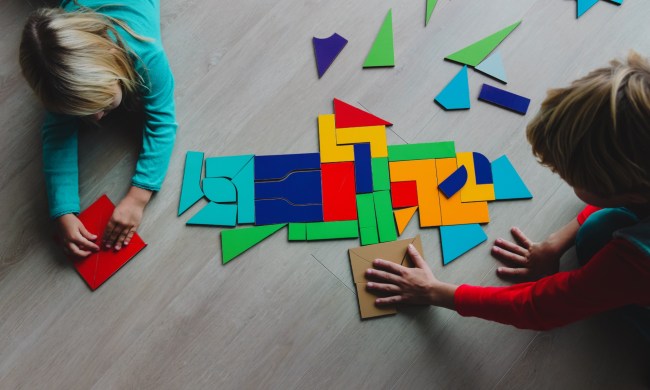
Seven up is another classic kids’ game that has definitely stood the test of time. This game has been played in countless classrooms throughout the U.S. since the 1950s. No one is actually sure who invented this popular game, but most people have played at some point. Seven up is also known by other names like heads up, heads down, thumbs down or thumbs up. Its name variations point toward the basic aspects of the hands-on game.
A majority of elementary school teacher has led several rounds of 7 up during their teaching careers. New teachers may want to add it to their menu of classroom games because it’s a perfect pick to fill time when waiting for a specialty teacher or transitioning to another subject.
Seven up is also a summer camp staple on rainy days. Parents may want to reacquaint it’s an easy game to get going and a fun way to keep a group of children occupied like at a birthday party when the food hasn’t arrived yet. To play, you need at least 14 kids, which is what makes it an ideal school, camp, or party game. Seven up can certainly be played with fewer kids, but it’s not as exciting with less players. So, are you ready to get those thumbs up? Let’s learn how to play heads up, 7 up.
How to play heads up, 7 up

The rules of how to play 7 up are pretty simple. A teacher or an adult chooses seven kids to go to the front of the room, while the rest of the participants put their heads down and their thumbs up. The seven people in the front of the room then walk around and push the thumb down of one person. When finished, the seven return to the front of the room.
When time is up or all seven players push a thumb down, the grown-up in the room calls, “Heads up.” The people whose thumbs were pushed down stand up. Then, the participants take turns going around the room with each person standing saying who did it. If the person guesses correctly, the child changes places with the person in the front and becomes a chooser for the next round. The object of 7 up is straightforward: to stay in the game as a chooser for as long as possible.
How to keep the game moving
Now that you’ve got the basics of how to play 7 up, it’s important to set some boundaries in the game to keep the rounds moving and to keep the tears to a minimum.
- Remind the seated players to keep their heads down until times up is called.
- Peaking is a definite no-no.
- Place a quick time limit on how long players can take to push a thumb down. Two to three minutes is sufficient.
- Have a two-to-three-minute time limit on children guessing.
Getting everyone involved
Heads up, seven up is a perfect classroom and camp game, but it’s also one where the tears tend to flow pretty quickly. One reason why kids get upset is that they don’t get their thumb pushed down. If your thumb isn’t pushed down, you never get the opportunity to go to the front of the room to be a chooser. This scenario usually happens because the choosers like to keep picking their best friends. To keep that from happening, add one more rule: Choosers can’t push down the thumb of the same person twice. Adding this rule helps remind kids to pick different people each round.
How many rounds should you play?
The number of rounds is up to the adult leading the game. A good rule of thumb is to try and have all the participants in the game have the chance to push a thumb down or have his or her thumb pushed down. The two-to-three-minute time limit helps to keep the game rolling, but if the kids seem bored after a couple of rounds, move on and play something else.
7 up variations

To give the classic version a makeover, try these fun 7 up changeups.
Have a player choose
One fun way to change up the dynamics of playing 7 up is to allow one of the participants to pick the seven choosers. If the round of 7 up is at a birthday party, the birthday boy or girl can call up the first batch of choosers.
Who is it?
Another way to step out of the usual heads up, seven up box is to have all the participants put their heads down and their thumbs up. Then, the adult in the room secretly taps one child who now become “it.” As “it,” the child walks around the room pushing down the thumbs of six participants. If someone’s thumb gets pushed down, he or she walks up front. When time is up, the adult calls, “Heads up.” The seated participants now take turns trying to guess which of the seven in front was “it.” Keeping quiet is a big plus in this 7 up version.
Make 7 up educational
Teachers know kids learn better when lessons are fun. Seven-Up can actually be used to practice math facts at any age, whether the skill is multiplication, addition, division, or even word problems. To play, randomly choose kids to solve a problem on a flash card. The first seven to answer correctly go up front. Then, heads go down and thumbs go up. Each person up front pushes down the thumb of one person. When “heads up” is announced, the kids stand, but instead of guessing who picked them, each person has to solve a problem. If they get the answer correct, the two change places. The chooser gets to stay in the game if the person he or she picked gets the question wrong.
This variation of how to play heads up, 7 up isn’t just for math. It can be used for spelling and vocabulary reviews, too. The difficulty of the questions can easily be adjusted to suit the developmental levels of the participants.
7 up for smaller groups
What if everyone wants to play 7 up, but you don’t have 14 or more players? That’s okay, just change up the number of people doing the choosing. If you have six kids, have two kids act as the choosers and the other four put heads down. For 10, have four pick and the other six stay seated.
Take 7 up outside
Seven up is primarily an inside game, but if you have the table space, take it outside. It can be a great family outdoor game if you have a backyard with tables. It can be an outside party game where tables are already set up for eating. A few rounds of 7 up is a fun way to keep partygoers occupied while waiting for food or the cake to arrive.
Why heads up, seven up is awesome to play with kids

Most adults have fond memories of playing 7 up in school, camp, or at a party. There’s a reason why this classic is still around. It’s a simple game and perfect to play with larger groups of kids. Seven up also works for different age groups. Playing 7 up offers other benefits for kids, too.
heads up, seven up is an ideal game to play with kids as an icebreaker. It’s also a great pick when you want children to learn each other’s names. Playing 7 up helps kids learn how to wait, take turns, and remain present during the game. If your attention wanders, it’s unlikely you’ll get the opportunity to be a chooser. Seven up also teaches kids to use their other senses to try and guess who pushed their thumbs down. In order to try and figure out who pushed down their thumb, kids need to relay on the subtle clues they pick up with their ears, nose, and even their sense of touch.
Heads up, thumbs down

Seven up has stood the test of time simply because it’s an engaging guessing game where participants want to stay in it to win it. In today’s tech-savvy world, heading back to simpler games that get kids talking, giggling, and thinking is time well spent away from screens. If you’ve forgotten the rules, now you know the ins and outs of how to play heads up, seven up the traditional way as well as how to change it up.



